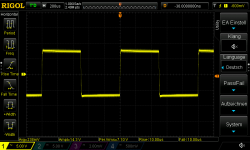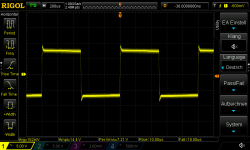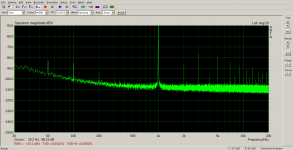TPA3255 gain 10db on 50V
Thank you.
If the snubber does not heat too much, splendid
Best regards
Roger
chips666
We take those tests and work on reducing those noises because we believe that they have an influence on SQ. So not a race to THD but a race to minimize what we believe can affect SQ.
The amp that you presently have seems to be very competently designed .
I'm completely ok with that, hence a careful implementation of the whole, power supply, input stage, TPA, a lot of protection, a lot of work!
Regards
Bobo
I would say the following....
However, if some of us feel that its module sounds great and probably better than 3E Audio, TI EVM etc ... and if the future measurements show that this module is finally disappointing: what would we do?
Amps SQ is not based direct on THD+N data . If Drmordor tests shows mediocre test data (this is likely the reason why data was not provided ) it should not stop you from enjoying the SQ. TPA3255 is a wonderful IC and if we use a good PSU , good inductors it will sound amazing .
However , if you want to hear what TPA3255 can achieve compared with best of the best , H3 (or more) should be non existent , EMI should be reduced and SW frequency should be attenuated by 40db at least .
Further a quasi resonant LLC half bridge is a wonderful SMPS , but noise on output should be measured and decreased under 1uV at all loads on both 50V and your second voltage.(yes it should be dual LLC so you can feed clean power to 12V Dvdd lines.)
Then and only then , you can hear what TPA3255 can really do.
Are you trying to accuse me of non-existent?If Drmordor tests shows mediocre test data (this is likely the reason why data was not provided )
I thought better of you
Anyhow,
Some of us will definitely test this new TPA3255 and as for myself, my ears will decide
I have heard and used TI,Hypex, Icepower and Purifi and for me, the audible differences are very small
Love this TPA3255 chip from the first time i heard it
It would be nice to see measurements confirming what i am experiencing
Good luck to you all
Enjoy...

Some of us will definitely test this new TPA3255 and as for myself, my ears will decide
I have heard and used TI,Hypex, Icepower and Purifi and for me, the audible differences are very small
Love this TPA3255 chip from the first time i heard it
It would be nice to see measurements confirming what i am experiencing
Good luck to you all
Enjoy...
cdsgames Wait, believe me, my measurements are not worse than yours)))
Sorry Doc its not about believing , its about seeing
You have been asked many times and frankly , as en engineer , if today is your first test (since you have no data) , how do you expect to reach our numbers ? We took hundreds , every time we changed a cap , a resistor , every time we increase a trace , every time..
Do you honestly believe you can reach -118 THD on your first test ?
Come on ..
Do you honestly believe you can reach -118 THD on your first test ?
Never consider yourself smarter than others.
But we remember that the THD figure doesn't really affect the subjective perception of sound? It is rather important that
a) the spectral composition of harmonics when operating on a complex load
b) the relationship between harmonics
c) a change in the spectral composition of distortions from power, frequency and load
d) the complex output impedance of the amplifier in the range of frequencies and loads and many more things that are one or two numbers in standard tests are not described, what can you do ...
Never consider yourself smarter than others.
But we remember that the THD figure doesn't really affect the subjective perception of sound? It is rather important that
a) the spectral composition of harmonics when operating on a complex load
b) the relationship between harmonics
c) a change in the spectral composition of distortions from power, frequency and load
d) the complex output impedance of the amplifier in the range of frequencies and loads and many more things that are one or two numbers in standard tests are not described, what can you do ...
Ok so show you test data and how you took into consideration all that ? Otherwise its just empty words.
Last edited:
I am interested in the conditions of your measurements
I have been interested in ANY of your test data. You can find some of my test data on previous posts including very clear conditions .
Last edited:
I agree that TPA3255 has much potential. most of the time THD is dominated by output coils, so take the biggest ones for the best numbers.
I never liked that much TIs proposal for PFFB: With a fixed voltage gain of 19.6dB - there is not much to gain. Less than 10dB improvement at the expense of a very high output level / low distortion audio front end (AFE). No.
Without that I measured k1/k2 = 105 dB @5Ohms load 1kHz.
I stopped further squeezing THD and focused on square wave response. With a different approach of PFFB I achieved a stable square wave over the full range of 5R output load to open circuit. And this works without the zobel - which I dislike as well for obvious reasons.
It is always a compromise - depending on the focus
I never liked that much TIs proposal for PFFB: With a fixed voltage gain of 19.6dB - there is not much to gain. Less than 10dB improvement at the expense of a very high output level / low distortion audio front end (AFE). No.
Without that I measured k1/k2 = 105 dB @5Ohms load 1kHz.
I stopped further squeezing THD and focused on square wave response. With a different approach of PFFB I achieved a stable square wave over the full range of 5R output load to open circuit. And this works without the zobel - which I dislike as well for obvious reasons.
It is always a compromise - depending on the focus
Attachments
And this an example of good engineering(my opinion) . Test data , focus on specific measurements , improvements .
I don't understand your Zobel dislike , its not obvious to me . I consider Zobel a must for good SQ..
Do you have a FFT 4 or 8R 5W or 10 ? (1Khz) (specify voltage )
I don't understand your Zobel dislike , its not obvious to me . I consider Zobel a must for good SQ..
Do you have a FFT 4 or 8R 5W or 10 ? (1Khz) (specify voltage )
Last edited:
My dislike of zobel is based on the underlying math applying for damping a LC-Filter. For aperiodic damping, the zobel resistor should be R=sqrt(L/C) which is several ohms here. An adaquate zobel cap should be several times bigger than the filter cap - something like 3uF in our case. Such values are impractical as the zobel resistor will burn instantly on the first hi note with substantial output level.
My claim can easyly be checked with a basic spice simulation comprising a 1kHz square source feeding the LC-filter dampened by the snubber.
And this is a dilemma without a solution in sight.
In TI appnotes you see zobel networks with ridicilous small capacitances and smd resistors that will burn whenever the output is ringing on its underdampened resonant frequency.
That is why I consider the hole attempt useless.
On the other hand you may argue that modern digital soundsources passing a 20kHz brickwall filter never will trigger the LC-resonant peak in the ballpark of 50 kHz. I agree with that - but why on earth do we require a zobel then?
I will find some FFTs, maybe from 2017. Resolution is limited by soundcard EMU-0202, no AP-setup available here.
My claim can easyly be checked with a basic spice simulation comprising a 1kHz square source feeding the LC-filter dampened by the snubber.
And this is a dilemma without a solution in sight.
In TI appnotes you see zobel networks with ridicilous small capacitances and smd resistors that will burn whenever the output is ringing on its underdampened resonant frequency.
That is why I consider the hole attempt useless.
On the other hand you may argue that modern digital soundsources passing a 20kHz brickwall filter never will trigger the LC-resonant peak in the ballpark of 50 kHz. I agree with that - but why on earth do we require a zobel then?
I will find some FFTs, maybe from 2017. Resolution is limited by soundcard EMU-0202, no AP-setup available here.
Last edited:
Once again, and IMD.Never consider yourself smarter than others.
But we remember that the THD figure doesn't really affect the subjective perception of sound? It is rather important that
a) the spectral composition of harmonics when operating on a complex load
b) the relationship between harmonics
c) a change in the spectral composition of distortions from power, frequency and load
d) the complex output impedance of the amplifier in the range of frequencies and loads and many more things that are one or two numbers in standard tests are not described, what can you do ...
Also saw on another forum that there might be a possibility of audible IMD source(s) from ultrasonic energy, so there's that too.
cdsgames Wait, believe me, my measurements are not worse than yours)))
Sorry Doc its not about believing , its about seeing ... Do you honestly believe you can reach -118 THD on your first test ?
Come on ..
Engineers are such an odd breed, demanding to see each other's "stuff" and insisting that their own measurements are smaller!
- Home
- Amplifiers
- Class D
- TPA3255 - all about DIY, Discussion, Design etc


